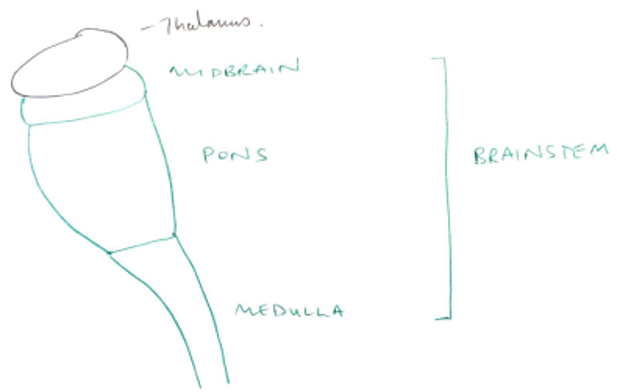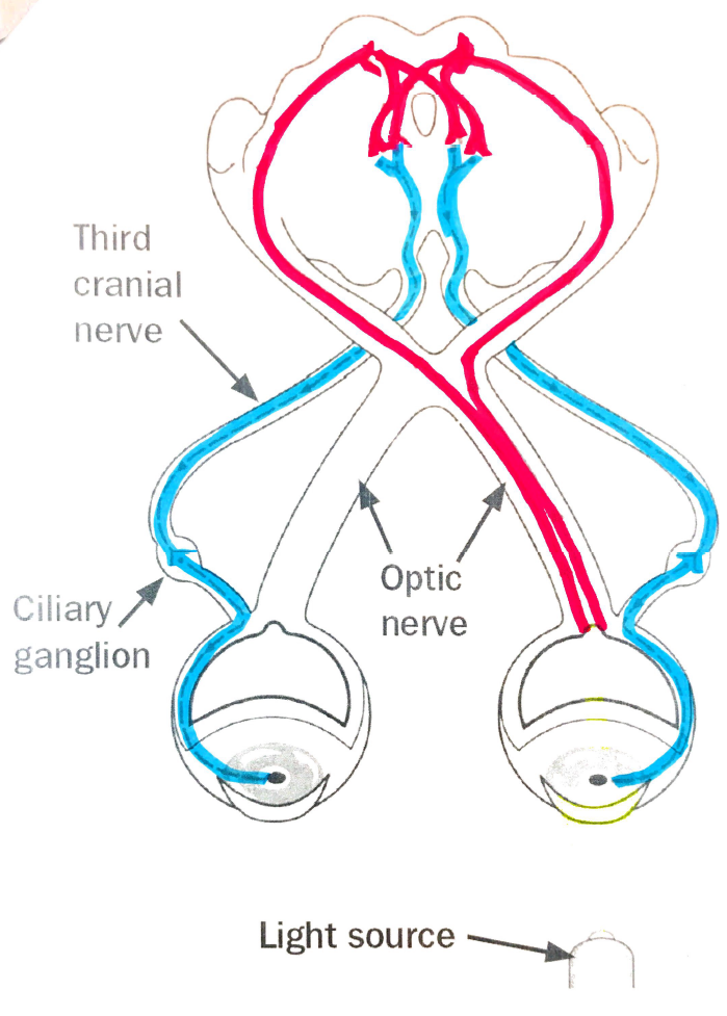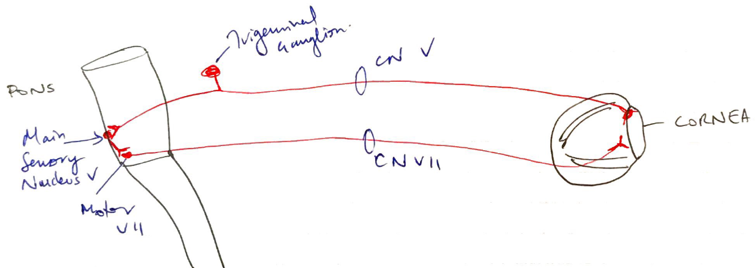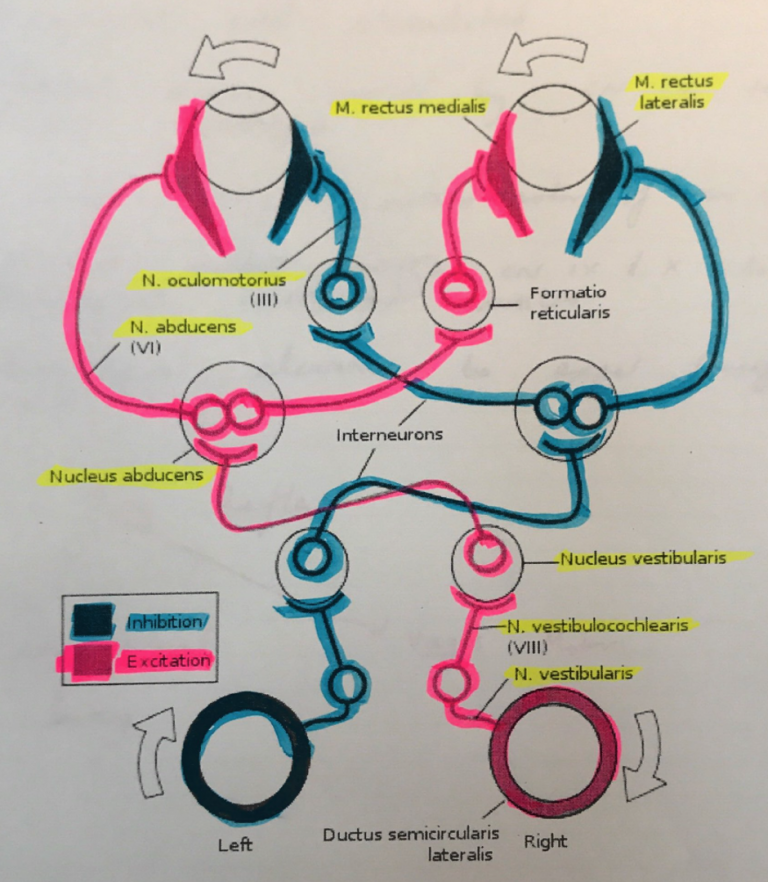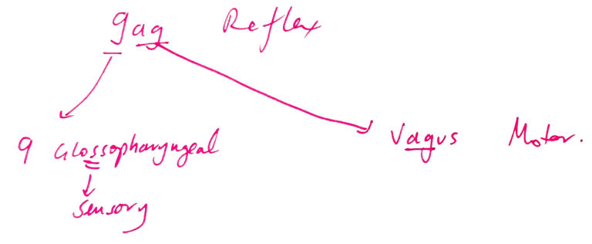K1i: Anatomy of CN relevant to brain stem reflexes
- Brainstem = central trunk of the brain which continues downwards to form the SC
Function
- Relays signals from CNS ⮂ peripheries
- Control centre for functions vital to life
Brain Death Definition
- The irreversible loss of all brain function, including the brainstem:
- 3 essential findings:
- Coma (unresponsiveness)
- Absent brainstem reflexes
- Apnoea
* Preconditions must be met*
Brainstem Reflexes
Pupillary Light Reflexes
- CN II OPTIC
- CN III OCCULOMOTOR
- Afferent Limb
- Light shined simulates retinal photoreceptors
- Retinal ganglion cells transmit to Optic N whose cell bodies lie in retina
- CN II enters skull via optic canal
- At optic chiasm the nasal retinal fibres cross to contralateral optic tract
- Temporal fibres stay in ipsilateral optic tract
- Fibres terminate in PRETECTAL NUCLEUS
- Pretectal nuclei project fibres to ipsi & contralateral EDINGER WESTPHAL NUCLEUS
- Efferent Limb
- EWN projects pre-ganglionic parasympathetic fibres which travel along CN III & synapse in CILIARY GANGLION onto post-ganglionic parasympathetic fibres
- Post ganglionic parasympathetic fibres innervate sphincter m. of pupils à PUPILS CONSTRICT
= Direct & consensual light reflex
Corneal Reflex
→ CN V TRIGEMINAL N (OPTHALMIC BRANCH) Afferent
→ CN VII FACIAL N Efferent
- Light touch receptors in conjunctiva & cornea stimulated
- Pass via OPTHALMIC BRANCH of TRIGEMINAL N & through Trigeminal Ganglion to Main Sensory Nucleus of Trigeminal n.
- Interneurons transmit to Motor Nuclei of Facial n.
- Facial n. supplies ORBICULARIS MUSCLE
- Closure of eyelids
Reflex Response to Pain in Trigeminal Distribution
- CN V TRIGEMINAL N
- CN VII FACIAL N
(Apply pain to supraorbital region (V) → No facial movement (VII))
- Main Sensory Nucleus lies in pons & receives light touch sensation
- Postganglionically Trigeminal N. divides into OPHTHALMIC, MAXILLARY & MANDIBULAR NERVES
- Interneurons transmit to Motor Nuclei of Facial N (in Pons near border with Medulla)
- Facial N. carries motor control to all facial m. except eye muscles
Vestibulo-Ocular Reflex (VOR)
- CN III OCULOMOTOR N
- CN IV TROCHLEAR N (Vertical response)
- CN VI ABDUCENS N (Horizontal response)
- CN VIII VESTIBULOCOCHLEAR N
Vor Test Basis
- Activation of vestibular movement causes eye movements
- Reflex to stabilise visual field on retina
- Move head → eyes move opposite direction
- VOR does not require visual input & can be elicited by caloric (cold/hot) stimulation of inner ear & in total darkness!
Caloric Testing
- Ice cold (<30°C) water is irrigated into external auditory canal
- Temperature difference b/w body & water creates a convective current in endolymph of semicircular canal
- If water COLD the endolymph falls
→ ↓rate of vestibular firing → mimics head turn to contralateral side
→ eyes turn to ipsilateral side (fast movement) & nystagmus (slow movements) to correct towards contralateral ear
COWS = Cold opposite, warm same
- WARM water → endolymph rises → ↑firing vestibular afferent n. → mimics head turn to ipsilateral side → both eyes turn to contralateral ear (fast) & ipsilateral ear (slow = nystagmus) to correct
- ∴ VOR elicits = PHYSIOLOGICAL NYSTAGMUS
- Nystagmus = rhythmic abnormal eye movements
- Slow movement driving eye off target
- Fast follow up movement bringing eye back to target
- ∴Absence of VOR = Brainstem not working
Vor Test
- Cold H2O causes endolymph to fall
- ↓Vestibular N (CN VIII) afferent firing
- Mimics head turn to CONTRALATERAL SIDE of H2O irrigation
- Transmitted via Vestibular ganglion to vestibular nucleus in brainstem
- Vestibular nuclei fibres cross to Contralateral Abducens Nucleus (CN VI)
- In the abducens nuclei, they synapse at 2 pathways:
- Direct to IPSILATERAL Lateral Rectus Muscle via Abducens n (VI)
- To CONTRALATERAL Medial Rectus Muscle via Oculomotor N (III)
Also inhibitory pathways in IPSILATERAL abducens nucleus so that ipsilat. (to cold stimulus) the lateral rectus & contralateral medius rectus are inhibited
- Slow movement eyes towards IPSILAT
- Fast movement (NYSTAGMUS) to CONTRALAT
- Abnormal HORIZONTAL (III, VI, pons)
- Abnormal VERTICAL (III, IV, Midbrain)
Pharyngeal (GAG) Reflex
- CN IX GLOSSOPHARYNGEAL Afferent
- CN X VAGUS Efferent
- Pharyngeal wall stimulated
- Afferent sensory carried by CN IX to Nucleus Ambiguus
- Nucleus Ambiguus contains motor of CN IX, X, XI
- Efferent output through CN IX & X to pharyngeal constrictor muscles
- Pharyngeal elevation to expel foreign object
Cough Reflex
- CN X VAGUS Afferent & Efferent
- Irritant receptors on posterior wall trachea, pharynx & tracheal carina
- Via Internal Laryngeal N. branch of the Superior Laryngeal n. of the Vagus (X) to Medulla
- Motor signals transmitted via Superior Laryngeal n. of Vagus (X) to glottis, external IC & diaphragm
- Diaphragm (phrenic) & external IC (intercostal n’s) contract
- Negative intrathoracic P
- Air rushes into lungs
- Glottis shuts (Recurrent Laryngeal N. of Vagus X) & vocal cords shut
- Abdominal m. & resp m. contract simultaneously generating v. high P > 300mmHg
- ↑intrathoracic P
- VC relax → glottis opens → air expelled @ 100mph
- Clearing irritants as air sweeps up
